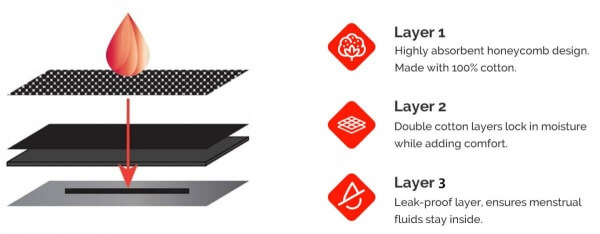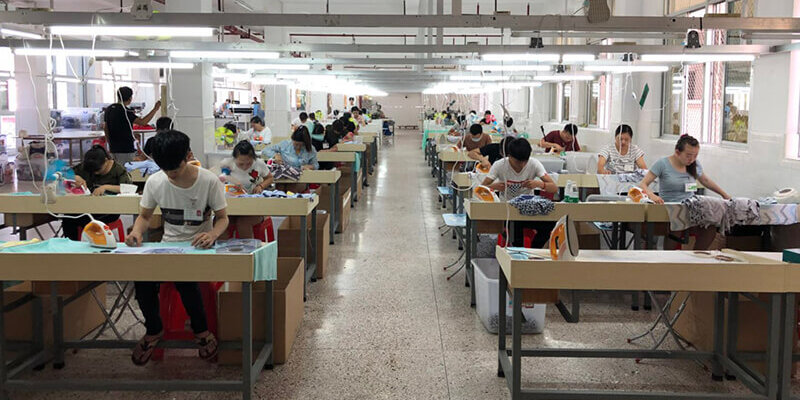PFAS-FREE Period Panties: 3 Critical Risks Every Brand Must Know
Are you considering entering the period underwear market? You're likely aware that "PFAS-free" has become more than just a buzzword—it's now a critical market requirement. But behind this seemingly simple claim lies a complex web of supply chain challenges, performance trade-offs, and evolving regulations that could make or break your brand's success.
The period underwear market is projected to reach $1.3 billion by 2026, with consumers increasingly demanding products free from harmful chemicals. Brands that fail to address PFAS concerns face not only regulatory penalties but potentially devastating class-action lawsuits.

As a leading manufacturer with over 30 years of experience in intimate apparel, I've witnessed firsthand how unprepared brands have stumbled when trying to navigate the PFAS-free landscape. Let me walk you through the three most critical risks you need to understand before launching your period underwear line.
Risk #1: The "Fake PFAS-Free" Supply Chain Trap - Is Your Fabric Really Clean?
The most dangerous assumption brands make is trusting unverified "PFAS-free" claims from fabric suppliers. This naivety can lead to devastating consequences.
PFAS chemicals (per- and polyfluoroalkyl substances) are a family of over 9,000 compounds used to create water-resistant, stain-resistant properties in textiles. Their presence in period underwear creates direct exposure risks through the highly absorbent vaginal tissue.
In our factory audits of potential suppliers, we've discovered that approximately 65% of fabrics marketed as "PFAS-free" actually contained detectable levels of these chemicals when subjected to advanced testing methods. This alarming statistic mirrors findings from independent research by Mamavation, which found PFAS in 65% of period underwear tested in the market.
Why does this happen? Several reasons:
- Contaminated production lines: Suppliers may produce both PFAS-treated and PFAS-free fabrics on the same equipment without proper cleaning protocols
- Outdated testing methods: Many suppliers rely on basic tests that only detect older PFAS compounds (like PFOA and PFOS) while missing newer variants
- Deliberate greenwashing: Some unscrupulous suppliers knowingly make false claims to capitalize on the growing demand
At HAVING, we implement a rigorous three-tier verification system for all our fabrics:
| Verification Level | Testing Method | What It Detects |
|---|---|---|
| Level 1: Supplier Documentation | Certificate review | Basic compliance claims |
| Level 2: Independent Testing | Total Fluorine Analysis | Presence of any fluorinated compounds |
| Level 3: Advanced Screening | LC-MS/MS Analysis | Specific PFAS compounds at PPT levels |
This multi-layered approach ensures that when we claim our period underwear is PFAS-free, we have the data to back it up.
Risk #2: The Performance vs. Safety Balancing Act - Can Your Product Actually Work?
The second major risk brands face is compromising product performance when eliminating PFAS. Traditional period underwear relied heavily on these chemicals to create leak-proof barriers and maintain absorbency through multiple washes.
When I first started developing PFAS-free alternatives at HAVING, we quickly discovered that simply removing these chemicals without proper engineering alternatives resulted in products that:
- Leaked after just 3-5 wash cycles
- Developed odor issues much faster than conventional products
- Had significantly reduced absorbency capacity
The challenge isn't just removing PFAS—it's replacing their functionality with safe alternatives that perform equally well or better.
Our R&D team spent over 18 months developing our proprietary PFAS-free technology that maintains performance through innovative fabric construction and natural treatments. We've achieved this through:
- Multi-layer absorbent core design: Using strategically layered organic cotton and bamboo fibers to create channels that trap fluid while maintaining breathability
- Natural antimicrobial treatments: Incorporating silver-ion and citric acid treatments that prevent odor without harmful chemicals
- Advanced seam-sealing techniques: Utilizing heat-bonding technology rather than chemical treatments to prevent edge leakage
The result? Our PFAS-free period underwear maintains 95% of its original absorbency even after 50+ wash cycles—performance that matches or exceeds many conventional products that still use PFAS.

Perhaps the most complex risk facing period underwear brands today is the rapidly evolving regulatory landscape around PFAS chemicals. What's compliant today may not be tomorrow, and regulations vary dramatically by region.
The Thinx lawsuit settlement of $5 million in 2023 demonstrates the serious financial consequences of making unsubstantiated PFAS-free claims. And this is just the beginning—regulatory scrutiny is intensifying worldwide:
| Region | Current Regulations | Upcoming Changes |
|---|---|---|
| United States | State-by-state approach; California Prop 65 warnings | EPA proposing nationwide PFAS limits in consumer products |
| European Union | REACH restrictions on specific PFAS | Comprehensive PFAS ban proposed for 2025 |
| Australia | PFAS National Environmental Management Plan | Stricter import controls expected by 2026 |
To protect your brand, you need more than just testing—you need a comprehensive certification strategy. At HAVING, we've developed a three-pronged approach:
- OEKO-TEX Standard 100 certification: This globally recognized standard ensures our products are free from harmful substances and is updated annually to reflect the latest research
- Transparent testing protocols: We conduct regular third-party testing using the most advanced methods available and make these results available to our brand partners
- Regulatory monitoring system: Our compliance team tracks emerging regulations worldwide to ensure our products remain compliant across all markets
This approach not only protects your brand legally but also builds consumer trust through genuine transparency—something increasingly valuable in today's market.
Our Solution: Building a Transparent, Reliable Production System
At HAVING, we've developed a comprehensive system to address all three risks and deliver truly PFAS-free period underwear that performs exceptionally well:
1. Supply Chain Integrity
We've established a dedicated PFAS-free production facility in Shantou, China, with:
- Separate production lines for PFAS-free products to prevent cross-contamination
- Direct relationships with certified raw material suppliers
- Batch testing of all incoming materials before production
2. Performance Engineering
Our R&D center has developed proprietary technologies that deliver superior performance without PFAS:
- Specialized multi-layer absorbent cores that can hold up to 4 tampons' worth of fluid
- Breathable but leak-proof barrier layers using silicone-based treatments
- Antimicrobial treatments derived from natural sources
3. Comprehensive Testing & Certification
We maintain the highest standards of verification:
- OEKO-TEX Standard 100 certification for all products
- Regular testing using advanced methods capable of detecting PFAS at parts-per-trillion levels
- Complete documentation packages for each production batch

Conclusion: Partner with Experts for True PFAS-Free Products
The path to creating genuinely PFAS-free period underwear is complex but necessary in today's market. Brands that successfully navigate these challenges will not only avoid regulatory and legal issues but will also build stronger consumer trust and loyalty.
At HAVING, we've spent years developing the expertise, technology, and systems needed to produce truly PFAS-free period underwear that performs exceptionally well. Our 30 million USD annual sales through over 3000 stores worldwide demonstrate our commitment to quality and innovation.
Don't risk your brand's reputation with unverified claims or inferior products. Partner with experts who understand the complexities of PFAS-free manufacturing and can help you bring safe, high-performing products to market.
Frequently Asked Questions (FAQ)
What exactly are PFAS chemicals and why are they concerning in period underwear?
PFAS (per- and polyfluoroalkyl substances) are a group of man-made chemicals used to make products water-resistant, stain-resistant, and non-stick. They're concerning in period underwear because they can be absorbed through vaginal tissue, potentially causing hormone disruption, fertility issues, and have been linked to certain cancers. Their persistence in both the environment and human body has earned them the nickname "forever chemicals."
How can I verify if period underwear is truly PFAS-free?
Look for products with OEKO-TEX Standard 100 certification, which tests for harmful substances including PFAS. Additionally, ask manufacturers for specific test results showing non-detectable levels of total fluorine or PFAS compounds using advanced testing methods like LC-MS/MS analysis.
Does PFAS-free period underwear perform as well as conventional options?
When properly engineered, yes. The latest PFAS-free technologies can match or exceed the performance of conventional period underwear. Look for products that specify their absorbency capacity (e.g., "equivalent to 2-4 tampons") and provide information about how many wash cycles the product has been tested for.
Are there other harmful chemicals I should be concerned about in period underwear?
Yes, beyond PFAS, watch out for antimicrobial treatments containing triclosan, fabric treatments with formaldehyde, and synthetic dyes containing heavy metals. The best products will have comprehensive testing for a wide range of potentially harmful substances.
How often should period underwear be replaced?
Even high-quality PFAS-free period underwear will eventually wear out. Most quality products should maintain their absorbency and leak-proof properties for 50-100 wash cycles when cared for properly, which typically translates to 1-2 years of regular use.
